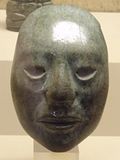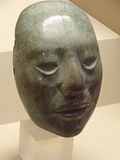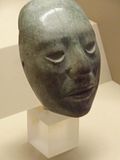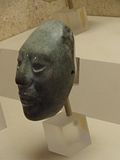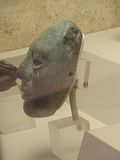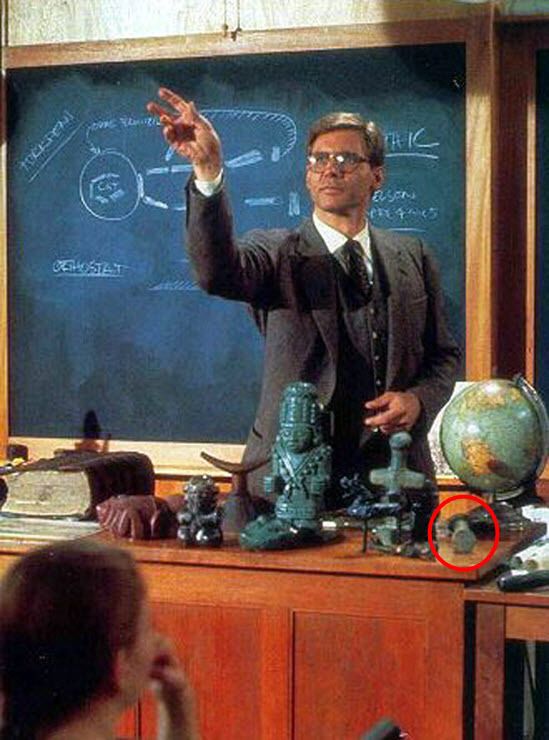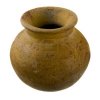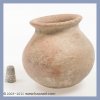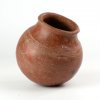Wonderful research! My kind of RPF thread!!
You are using an out of date browser. It may not display this or other websites correctly.
You should upgrade or use an alternative browser.
You should upgrade or use an alternative browser.
Raiders of the Lost Ark: The Marshall College desk artifacts
- Thread starter James Earl Cash
- Start date
Solos blaster
Sr Member
So cool seeing these. I had often wondered if they were dressed up souvenirs, just souvenirs or just things they made to put on his desk. The latter, which actually does seem the more painstaking task to accomplish. Can't wait to see more!
James Earl Cash
Active Member
Chapter VI - The red stone sculpture
This one was really hard.
Between the book and the Chimu vessel is a red stone sculpture:
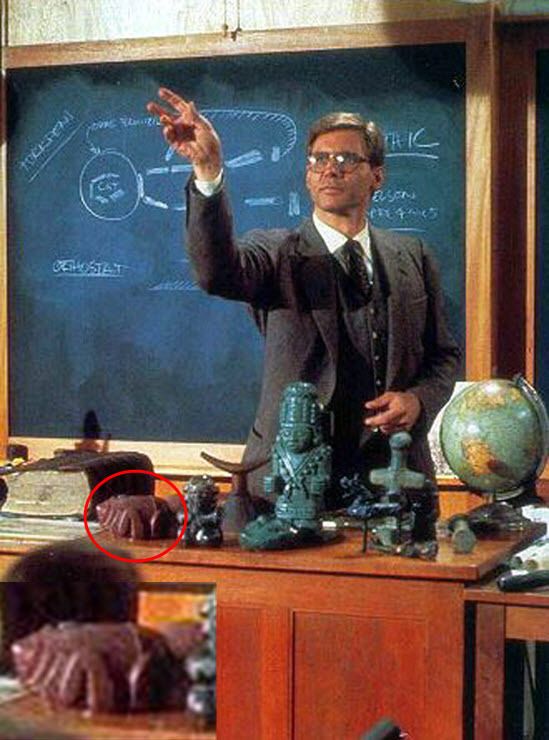
It’s round and has two openings on one side.
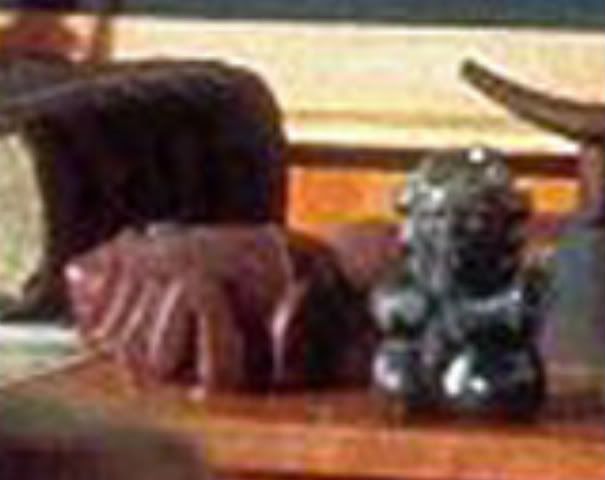
It could have been a model of a house or temple. It could have been also a weird Neolithic female idol.
But no and no. It doesn’t look like a human being. And it is hardly probable. that it is a model of a building or something.
Ok, there are some findings of model houses like in Egypt made of limestone, but the shape is different and they are not red.
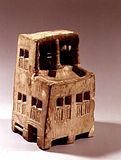
This object looks more zoomorphic.
And then the red color. It could be pottery or carved out of a stone. If it would be from stone it could be amber, carnelian, coral or jasper. Especially Egyptian Jasper can be very red.
So its zoomorphic it is red and probably ceramic or stone.
Which animal could this thing be? My first thought was a turtle. The two openings on one side could be for the legs of the turtle. I searched a lot of times through the net and found nothing similar.
Maybe it was a chimera. I don’t know. A long long time I found nothing. I searched everything like red pottery sculpture or ancient red stone figure and so on. Nothing.
I started to take a look again at the pictures and made a sketch and added something, which I noticed now:
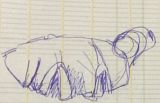
Also look at the enlarged section of the new photo I found and of the new BluRay screenshots. (Click to enlarge)
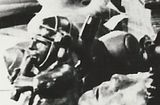
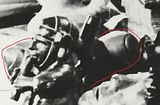

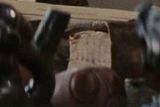
This object seems to have a head on one side. So the other side is the tail. If you look at the tail part, you can see that it’s segmented.
And then look at the parts, which I called openings or gates. You can see clearly coming out the shape of legs.
The order the legs are installed look exactly like from a .....
Could it really be so simple? Unfortunately I wasn’t aware, that this artifact was sitting on Indys desk. And I didn’t take any pictures of it, when I was in that museum.
It was so unremarkable besides those big artifacts. Also I was too busy then in finding another desk artifact....
- - - Updated - - -
If you want to find Indys artifact you have to take the pink metro line and stop at the station with this picture:
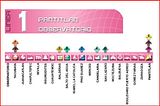

When you get out of the metro, you'll see this statue in the park on the way to the museum.
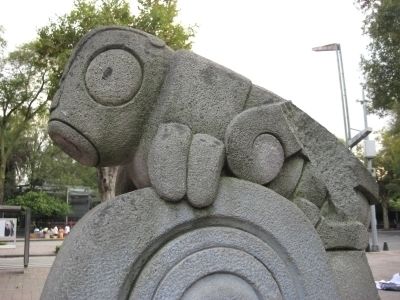
After a while you arrive at the museum...
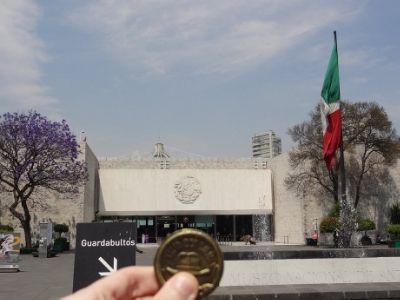
and go straight to the Sala Mexica, where Indys red artifact is:
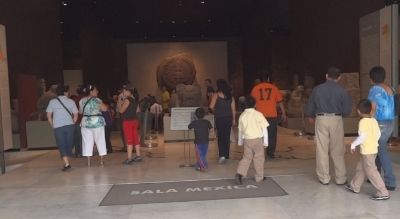
We are again in the National Museum of Anthropology in Mexico City, where we had our other desk artifact, the Aztec Noble statue.
The area and the metro station, where the National Museum of Anthropology is located, is called Chapultepec (Hill of the grasshopper).
So there were many things indicating to that, but I realized that after a long time, when I was at home again.
The segmented tail, the order of the legs and, if you look closely, the eyes of the statue show, that it is a sculpture of an insect, a grasshopper.
In fact there is this Aztec artifact made of a red stone (carnelian): The Chapulin, 19.5 by 18.5 by 47 centimeters, 1250 - 1521 A.D.
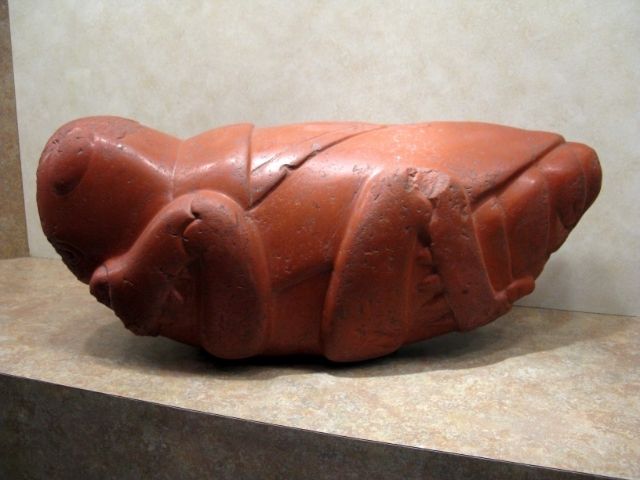
Here is the description on the Museums website: <Link>
You can find here also detailed pictures from all points of view.
And the google art project site with all info about the artifact: <Link>
Some more info from the Guggenheim exhibition catalogue 'The Aztec Empire' (2004):
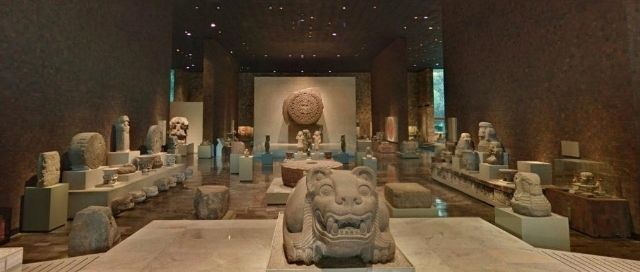
- - - Updated - - -
Here the detailed pictures of the 'Aztec grasshopper sculpture. Just click for larger pictures:

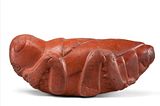
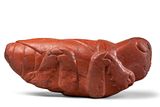
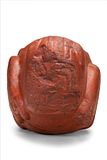
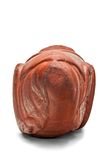

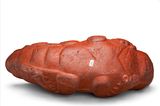
This one was really hard.
Between the book and the Chimu vessel is a red stone sculpture:

It’s round and has two openings on one side.

It could have been a model of a house or temple. It could have been also a weird Neolithic female idol.
But no and no. It doesn’t look like a human being. And it is hardly probable. that it is a model of a building or something.
Ok, there are some findings of model houses like in Egypt made of limestone, but the shape is different and they are not red.

This object looks more zoomorphic.
And then the red color. It could be pottery or carved out of a stone. If it would be from stone it could be amber, carnelian, coral or jasper. Especially Egyptian Jasper can be very red.
So its zoomorphic it is red and probably ceramic or stone.
Which animal could this thing be? My first thought was a turtle. The two openings on one side could be for the legs of the turtle. I searched a lot of times through the net and found nothing similar.
Maybe it was a chimera. I don’t know. A long long time I found nothing. I searched everything like red pottery sculpture or ancient red stone figure and so on. Nothing.
I started to take a look again at the pictures and made a sketch and added something, which I noticed now:

Also look at the enlarged section of the new photo I found and of the new BluRay screenshots. (Click to enlarge)




This object seems to have a head on one side. So the other side is the tail. If you look at the tail part, you can see that it’s segmented.
And then look at the parts, which I called openings or gates. You can see clearly coming out the shape of legs.
The order the legs are installed look exactly like from a .....
Could it really be so simple? Unfortunately I wasn’t aware, that this artifact was sitting on Indys desk. And I didn’t take any pictures of it, when I was in that museum.
It was so unremarkable besides those big artifacts. Also I was too busy then in finding another desk artifact....
- - - Updated - - -
If you want to find Indys artifact you have to take the pink metro line and stop at the station with this picture:


When you get out of the metro, you'll see this statue in the park on the way to the museum.

After a while you arrive at the museum...

and go straight to the Sala Mexica, where Indys red artifact is:

We are again in the National Museum of Anthropology in Mexico City, where we had our other desk artifact, the Aztec Noble statue.
The area and the metro station, where the National Museum of Anthropology is located, is called Chapultepec (Hill of the grasshopper).
So there were many things indicating to that, but I realized that after a long time, when I was at home again.
The segmented tail, the order of the legs and, if you look closely, the eyes of the statue show, that it is a sculpture of an insect, a grasshopper.
In fact there is this Aztec artifact made of a red stone (carnelian): The Chapulin, 19.5 by 18.5 by 47 centimeters, 1250 - 1521 A.D.

Here is the description on the Museums website: <Link>
You can find here also detailed pictures from all points of view.
And the google art project site with all info about the artifact: <Link>
Some more info from the Guggenheim exhibition catalogue 'The Aztec Empire' (2004):
So finally we have solved another mystery of Indy desk. Don't know, if there are other desk artifacts hiding in this place."This spectacular sculpture was discovered at the end of the nineteenth century in the main reservoir and canal system
that the Aztecs built in Chapultepec, where a freshwater spring fed into the canals that brought potable water to Mexico-Tenochtitlan.
The name 'Chapultepec' translates as 'hill of the grasshopper.' ...Grasshoppers also marked the period following the rainy season, when they blanketed crop fields."

- - - Updated - - -
Here the detailed pictures of the 'Aztec grasshopper sculpture. Just click for larger pictures:







James Earl Cash
Active Member
Just a few infos about Chapultepec before we go on to the next object.
Chapultepec was the first settlement of the Aztecs (or Mexica) in the Valley of Mexico during their migration from their legendary homeland called 'Aztlan' in the North.
And one side note:
In 1847 Chapultepec was also the site of the Mexican-American War, the Battle of Chapultepec, which also was one of the first military campaigns of the US Marine Corps.
The line 'From the Halls of Montezuma' in the Marines Hymn derives from that historical event.
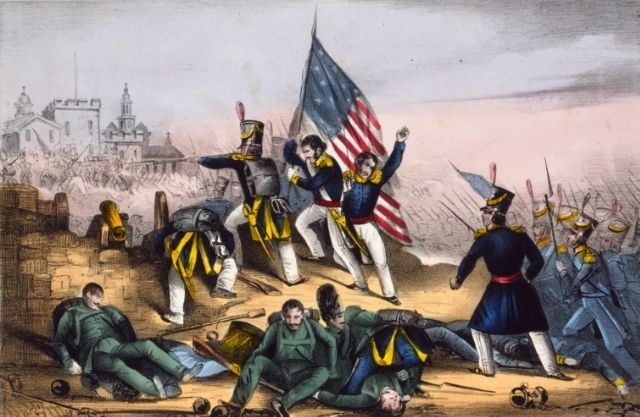
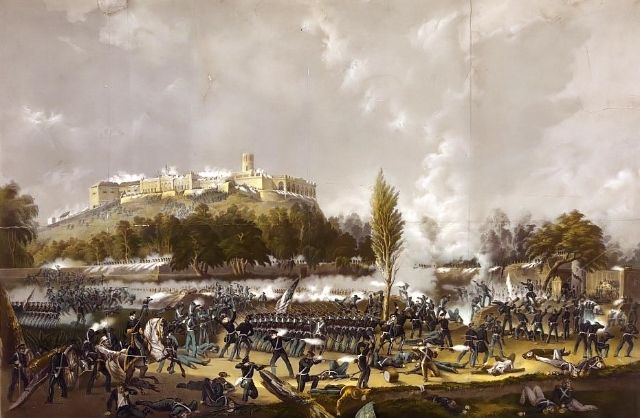
The back then disputed Castle of Chapultepec was till 1940 the residency of Mexican presidents. Now it's a museum.
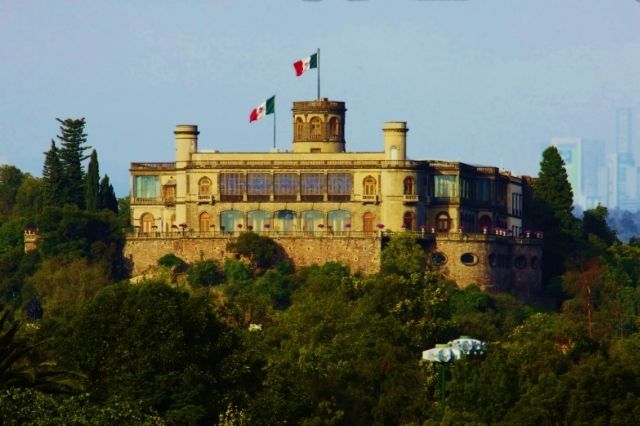
Chapultepec was the first settlement of the Aztecs (or Mexica) in the Valley of Mexico during their migration from their legendary homeland called 'Aztlan' in the North.
An article about grasshoppers in Mexican culture: <Link>'The Aztecs migrated from Aztlan to the Basin of Mexico and settled on the hill called Chapultepec. Pictograms show this with a grasshopper on its summit and it is therefore known as ‘grasshopper hill’.
A sweet-water spring on the mountain was later channelled to provide Tenochtitlan with drinking water. In Chapultepec the Aztecs built a system of reservoirs and canals. A sculpture of a grasshopper was discovered in the main reservoir towards the end of the 19th century. Grasshoppers are abundant in the fields in Mesoamerica after the rainy season.
The present piece was carved in a red volcanic rock called cornelian. The creature is depicted in all its anatomical detail and its legs are flexed as if it is ready to jump.'
From ‘Aztecs’ (Royal Academy of Arts exhibition catalogue, London, 2002), p.418.
And one side note:
In 1847 Chapultepec was also the site of the Mexican-American War, the Battle of Chapultepec, which also was one of the first military campaigns of the US Marine Corps.
The line 'From the Halls of Montezuma' in the Marines Hymn derives from that historical event.


The back then disputed Castle of Chapultepec was till 1940 the residency of Mexican presidents. Now it's a museum.

James Earl Cash
Active Member
Chapter VII - Green stone object
Infront of the Aztec noble we can see a green stone object.
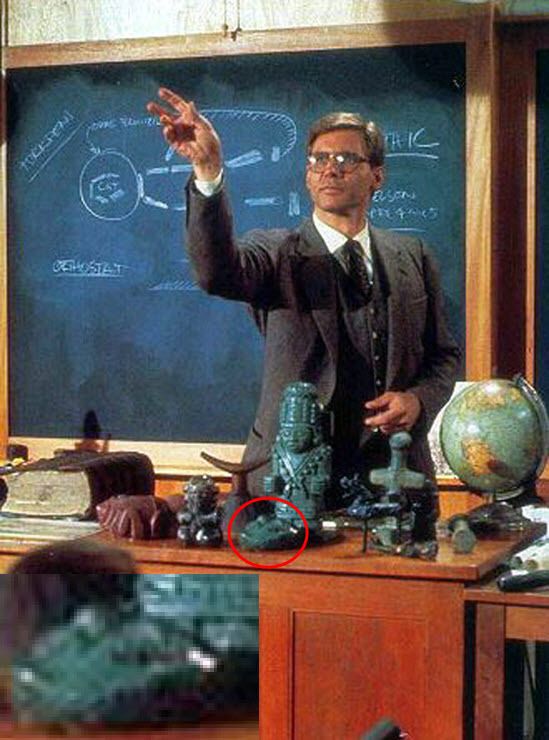
My first thought was, that it is a polished malachite.
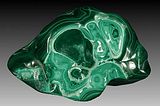
After getting more detailed pictures I discovered, that this stone looks more like a face.
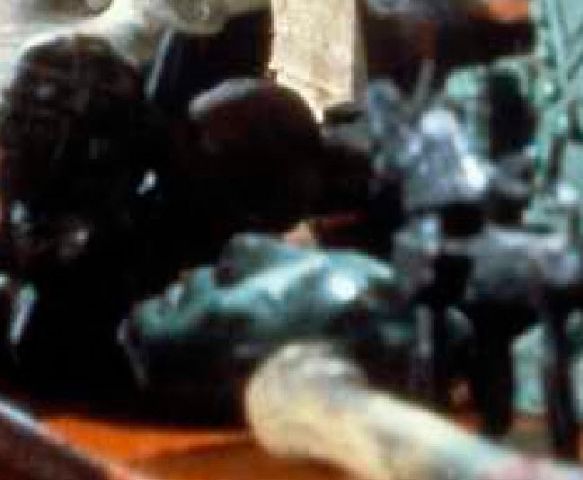
I found another reference picture, which confirms my assumption:
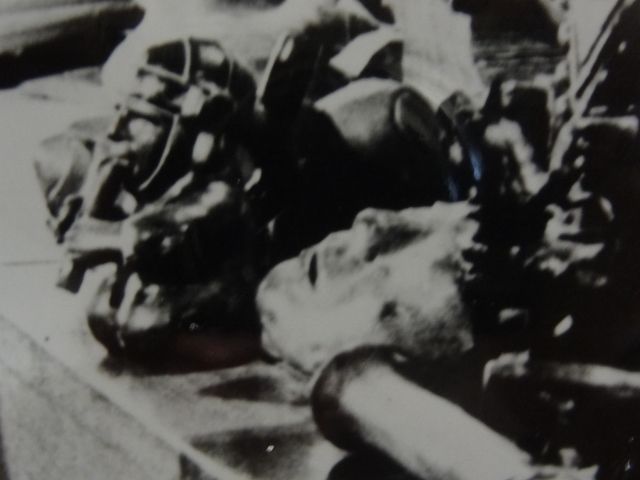
You can also see the Chimu vessel clearly in that picture.
Here the reference pictures: ( Click to enlarge)


- - - Updated - - -
If we summarize it, we have a green stone object in shape of a face.
So we are looking for a jade mask, which are more common for Mesoamerican Cultures.
I searched through the internet, through many books and found various masks.
Some of the most famous jade masks are here in this picture:
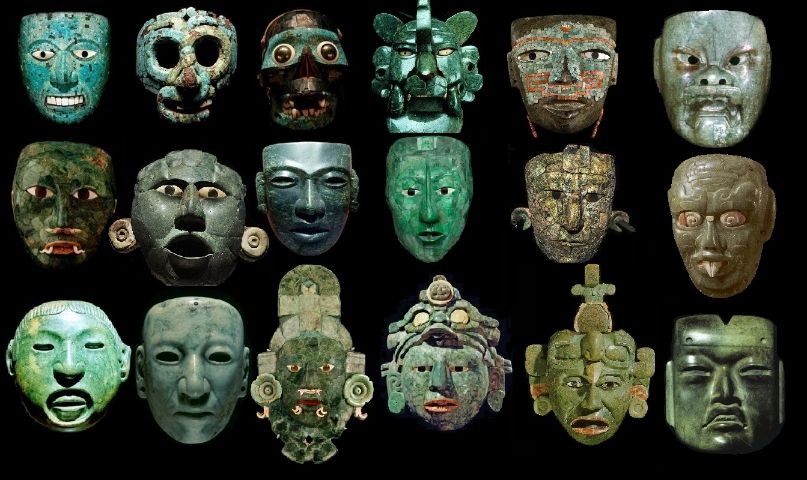
But none of them were similar to the one of Indy's desk.
I was nearly giving up my search, but then I entered this building....
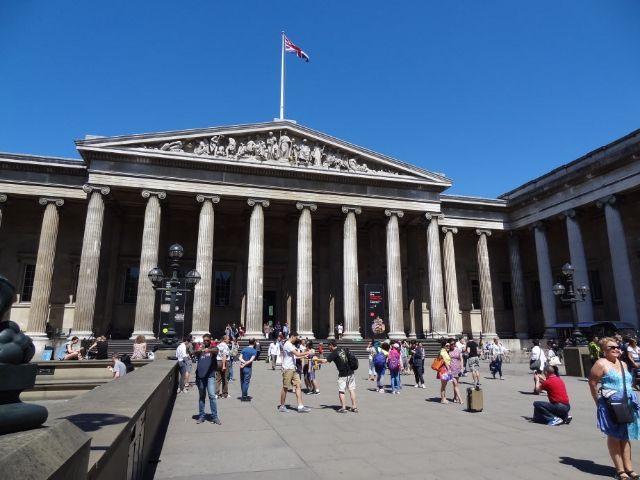
Infront of the Aztec noble we can see a green stone object.

My first thought was, that it is a polished malachite.

After getting more detailed pictures I discovered, that this stone looks more like a face.

I found another reference picture, which confirms my assumption:

You can also see the Chimu vessel clearly in that picture.
Here the reference pictures: ( Click to enlarge)


- - - Updated - - -
If we summarize it, we have a green stone object in shape of a face.
So we are looking for a jade mask, which are more common for Mesoamerican Cultures.
I searched through the internet, through many books and found various masks.
Some of the most famous jade masks are here in this picture:

But none of them were similar to the one of Indy's desk.
I was nearly giving up my search, but then I entered this building....

James Earl Cash
Active Member
So I entered this building and inside is a wonderful collection of Pre-Columbian artifacts.
They even had some excellent turquoise masks there. Mostly of Mixtec origin. Also a Crystal Skull is in the entrance area.
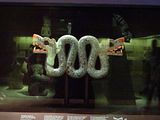
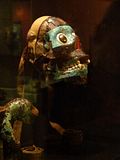
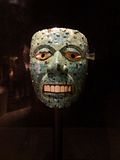
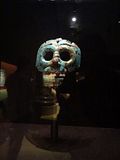

I haven’t been here since over ten years and many things had changed. It’s the British Museum.
While I was walking by the display cases, one object catched my eye. Could it really be this? I made some pictures of it and when I got back I compared it with the Marshall College mask.
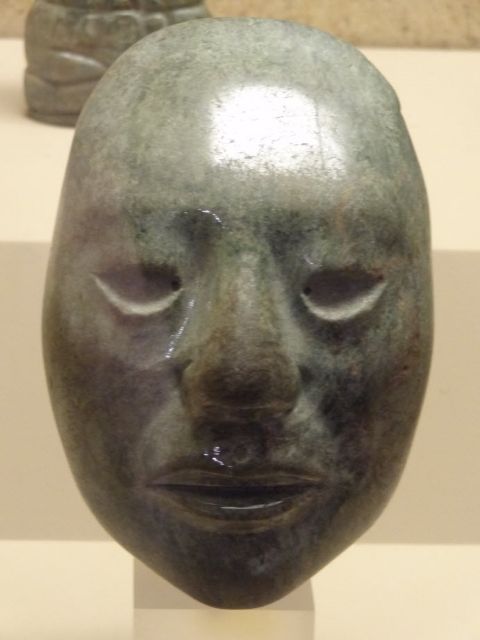
They even had some excellent turquoise masks there. Mostly of Mixtec origin. Also a Crystal Skull is in the entrance area.





I haven’t been here since over ten years and many things had changed. It’s the British Museum.
While I was walking by the display cases, one object catched my eye. Could it really be this? I made some pictures of it and when I got back I compared it with the Marshall College mask.

James Earl Cash
Active Member
James Earl Cash
Active Member
This artifact is a jade portrait head, which was found near the Mayan city of Copan in todays Honduras.
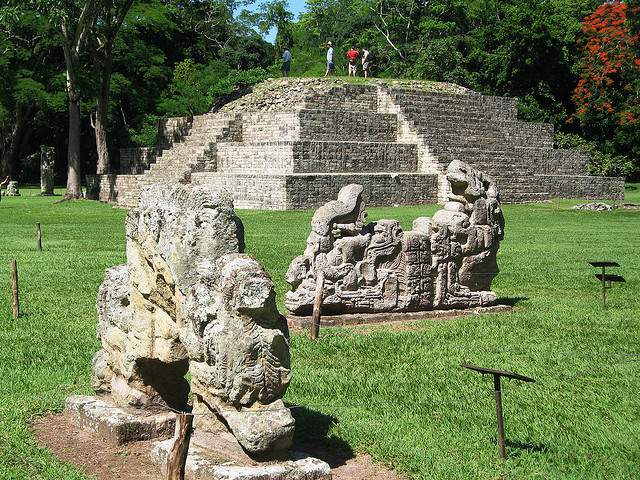
On the back side it has inscriptions (1+2), which name a lord of Palenque.
But read the text of the British Museum (3) or here (4).
Or direct link to the British Museum <click here>
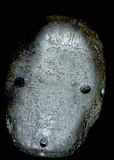

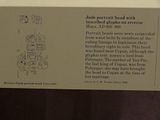

The mask is located in Room 27 of the British Museum, the Mexico Room:
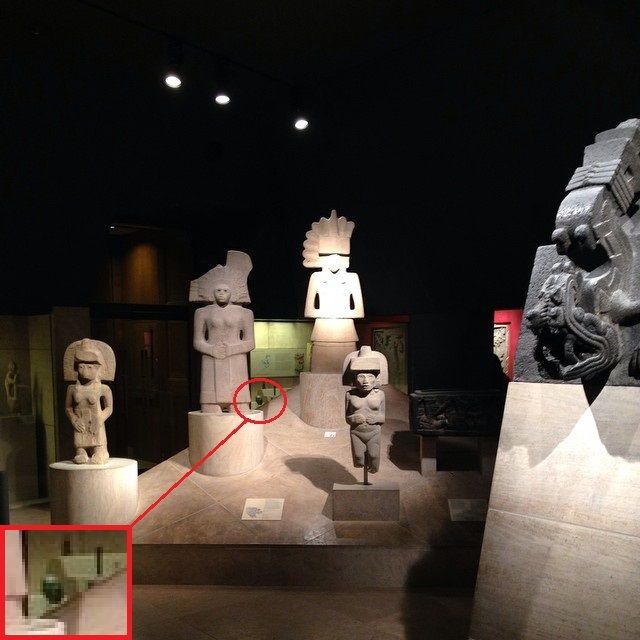
- - - Updated - - -
And another mystery solved. :thumbsup
Chapter VII: Mayan jade portrait head inscribed with glyphs
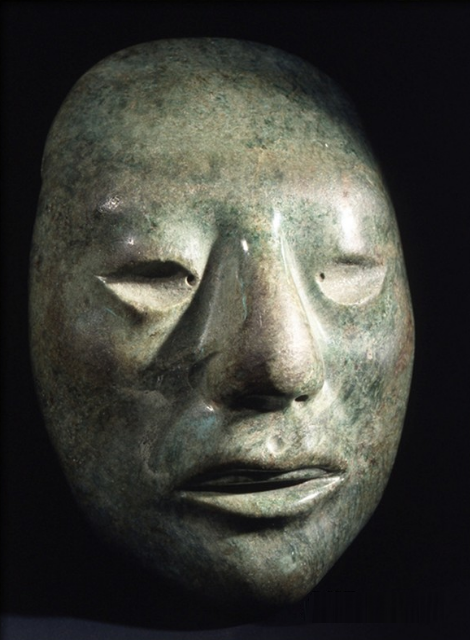

On the back side it has inscriptions (1+2), which name a lord of Palenque.
But read the text of the British Museum (3) or here (4).
Or direct link to the British Museum <click here>




The mask is located in Room 27 of the British Museum, the Mexico Room:

- - - Updated - - -
And another mystery solved. :thumbsup
Chapter VII: Mayan jade portrait head inscribed with glyphs

Awesome info! Now if only I could find a place to buy some of these things...
James Earl Cash
Active Member
Chapter VIII - Bronze votive figure
Close to the snow lion is a metal figurine:
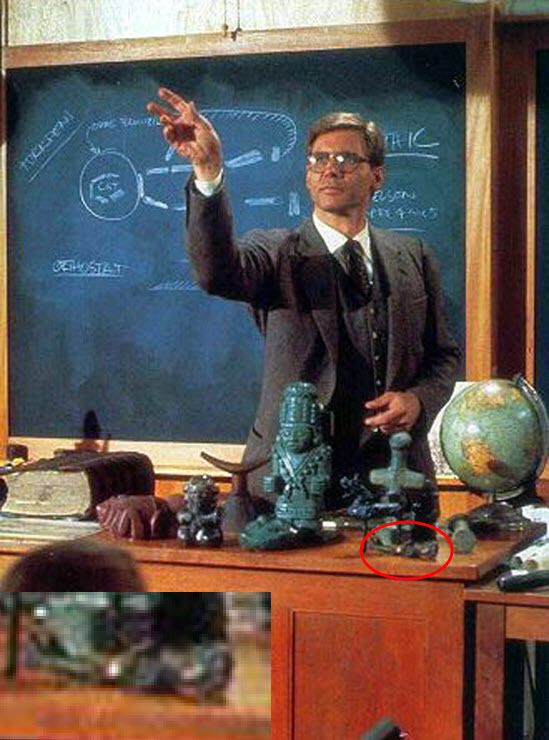
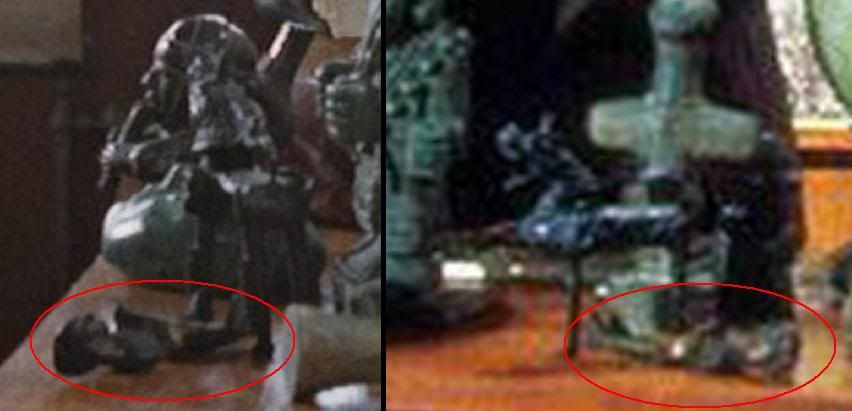
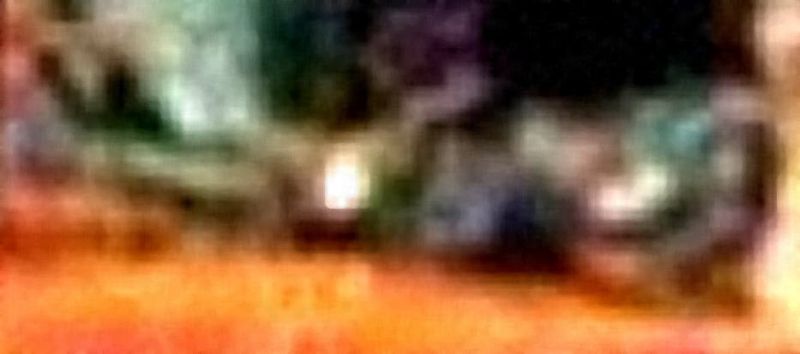
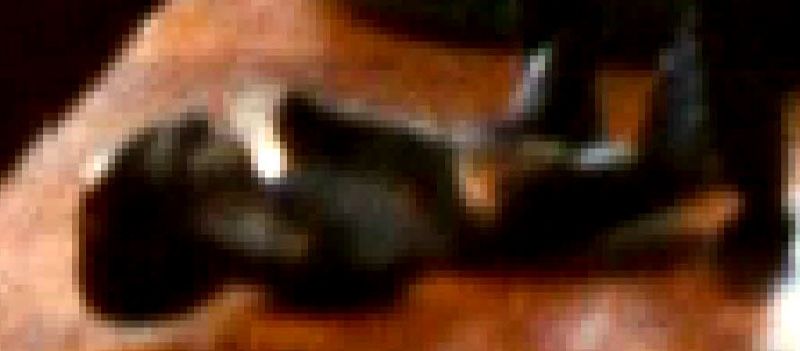
We see a metal figure, probably bronze, probably of a man. The head is bald, the neck seems long.
The two arms are united to one structure. Then again the legs are seperated.
The skirt looks like it is gilded.
There are a lot of bronze figures in the world. I found these, which look a bit like our searched object.
First one is from Turkey
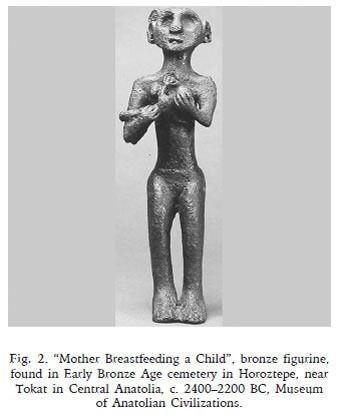
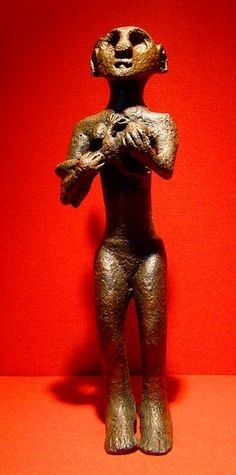
And the second one is from the Villanovan Culture, who lived in prehistoric Italy before the Etruscans.
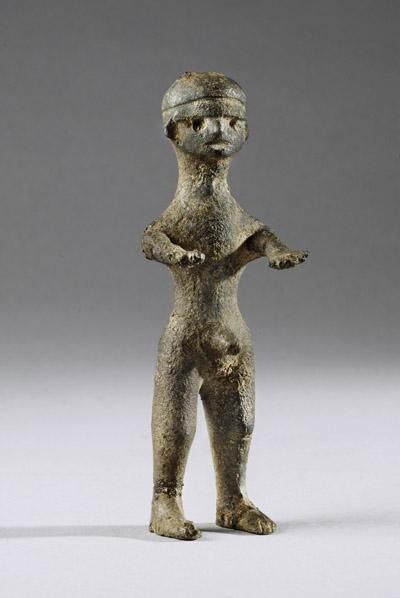
Here some more:
Again Turkey:
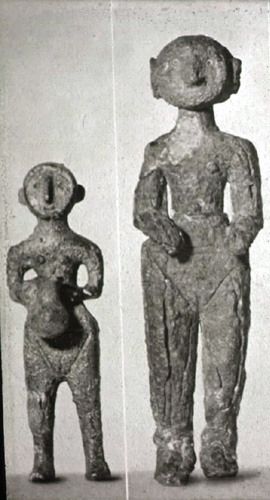
And from Spain an Iberian bronze figure:
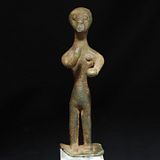
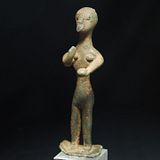
The arms are united like in a praying gesture. So I would think, that it must be a votive figure.
It will be very difficult to find the perfect match here due to the lack of detail.
Close to the snow lion is a metal figurine:




We see a metal figure, probably bronze, probably of a man. The head is bald, the neck seems long.
The two arms are united to one structure. Then again the legs are seperated.
The skirt looks like it is gilded.
There are a lot of bronze figures in the world. I found these, which look a bit like our searched object.
First one is from Turkey


And the second one is from the Villanovan Culture, who lived in prehistoric Italy before the Etruscans.

Here some more:
Again Turkey:

And from Spain an Iberian bronze figure:


The arms are united like in a praying gesture. So I would think, that it must be a votive figure.
It will be very difficult to find the perfect match here due to the lack of detail.
James Earl Cash
Active Member
James Earl Cash
Active Member
Chapter X - The Ritual Broom
On the left side of Dr. Jones desk is a group of one large object and three smaller ones :
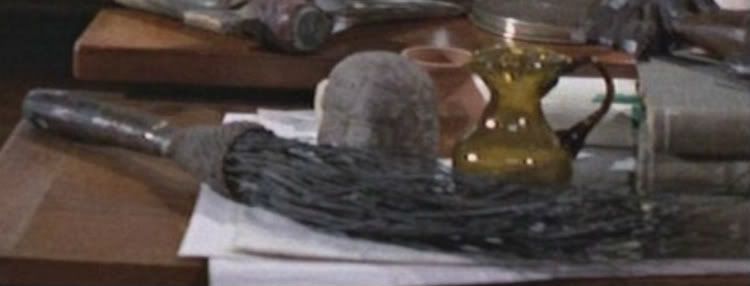
Marcus takes the large one in his hand while talking to Indy in the class room.

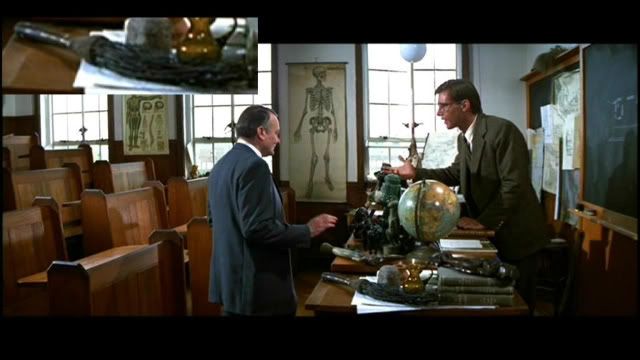
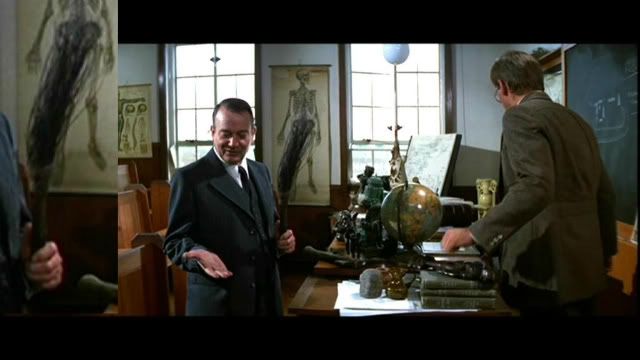
- - - Updated - - -
First I began my search for a fly whisk, which can be found in many cultures from Oceania to Asia and Africa.

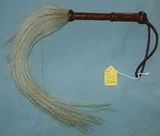

Especially in Africa fly whisks are status symbols for rulers and tribal leaders.
No, this time I didn't take the plane and traveled to Africa to reveal this mystery.
I contacted some vendors of African tribal art and asked about this object.
They told me, that it is not a fly whisk - It was a ritual broom!
- - - Updated - - -
The ritual brooms are common in Western and Central Africa, from Ivory Coast to Congo.
They are used by African priests, who dive the broom into holy water and sprinkle it onto the participants of the ceremony.


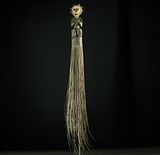
Kuba (Congo) -- Dan (Liberia/Ivory Coast) -- Mambila (Nigeria/Cameroon)
Ritual brooms are made of wood (handle) and of palm fibres (brush).
The priests also add and form leather onto the grip for a better handling.
Mostly the broom handles are sculpted as a figure or head.
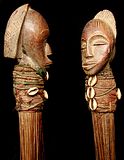
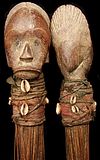

On the left side of Dr. Jones desk is a group of one large object and three smaller ones :

Marcus takes the large one in his hand while talking to Indy in the class room.



- - - Updated - - -
First I began my search for a fly whisk, which can be found in many cultures from Oceania to Asia and Africa.



Especially in Africa fly whisks are status symbols for rulers and tribal leaders.
No, this time I didn't take the plane and traveled to Africa to reveal this mystery.
I contacted some vendors of African tribal art and asked about this object.
They told me, that it is not a fly whisk - It was a ritual broom!
- - - Updated - - -
The ritual brooms are common in Western and Central Africa, from Ivory Coast to Congo.
They are used by African priests, who dive the broom into holy water and sprinkle it onto the participants of the ceremony.



Kuba (Congo) -- Dan (Liberia/Ivory Coast) -- Mambila (Nigeria/Cameroon)
Ritual brooms are made of wood (handle) and of palm fibres (brush).
The priests also add and form leather onto the grip for a better handling.
Mostly the broom handles are sculpted as a figure or head.



MAKE BELIEVE
Master Member
Thanks again for this great history (and movie history) class
James Earl Cash
Active Member
Thanks everyone!
I'm glad you like the thread so far.
Chapter XI - The Olmec head
Let's continue and go back to the group of three smaller items.
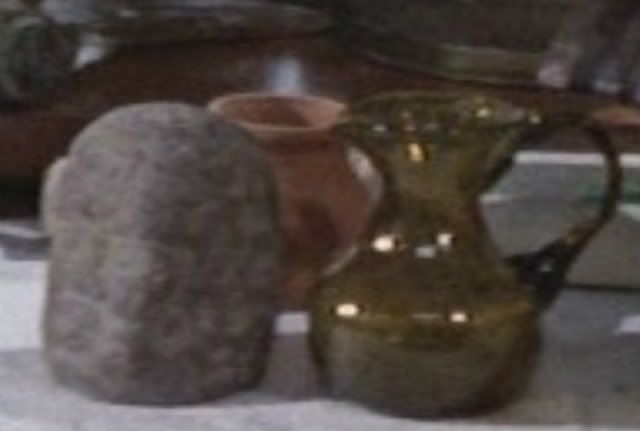
The one on the left is a miniature head of one of the colossal Olmec heads.
The olmec head looks like the head no. 1 or no. 6 found in San Lorenzo, Mexico.
San Lorenzo head no.1 is in the Museum in Xalapa:


Head no. 6 is displayed in the National Museum of Anthropology in Mexico City:
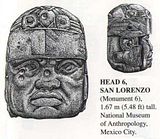
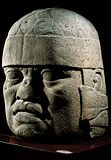
There were totally 17 colossal olmec heads found by now in Mexico. Ten of them were unearthed in San Lorenzo.
For more info:
Olmec heads Wiki Link
I'm glad you like the thread so far.
Chapter XI - The Olmec head
Let's continue and go back to the group of three smaller items.

The one on the left is a miniature head of one of the colossal Olmec heads.
The olmec head looks like the head no. 1 or no. 6 found in San Lorenzo, Mexico.
San Lorenzo head no.1 is in the Museum in Xalapa:


Head no. 6 is displayed in the National Museum of Anthropology in Mexico City:


There were totally 17 colossal olmec heads found by now in Mexico. Ten of them were unearthed in San Lorenzo.
For more info:
Olmec heads Wiki Link
James Earl Cash
Active Member
Chapter XII - Small amber glass jug
The second object of this group seems to be an amber glass pitcher.
At first I thought, it might be an artifact, maybe Roman glasswork.
But then I saw some of the Roman glasswork in museums, in antiquity shops and on the internet.
Here are some examples for a Roman glass pitcher:


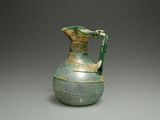
They look a bit different than this pitcher. Especially the shape of the handle.
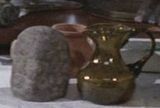
Here are some from the antiquity shops in Jerusalem:
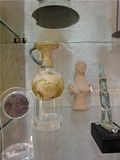
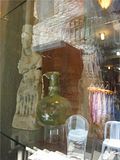
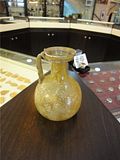
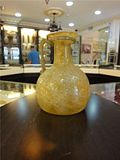
For the one in the right corner they wanted 650,-USD. But I was looking for a replica.
There were a few replicas in the museum shops like in the Israel museum.
But they were small and they had not the right color. And they were expensive, too.
Around 200,-USD, if I remember it right.
I think, it is a common amber colored crackle glass creamer (or pitcher or ewer) with a blackened handle,
which should be able to find everywhere. Height must be around 10cm (4 inches).
There are some on ebay, which look similar, but I haven't found the one with the exact shape yet.



The second object of this group seems to be an amber glass pitcher.
At first I thought, it might be an artifact, maybe Roman glasswork.
But then I saw some of the Roman glasswork in museums, in antiquity shops and on the internet.
Here are some examples for a Roman glass pitcher:



They look a bit different than this pitcher. Especially the shape of the handle.

Here are some from the antiquity shops in Jerusalem:




For the one in the right corner they wanted 650,-USD. But I was looking for a replica.
There were a few replicas in the museum shops like in the Israel museum.
But they were small and they had not the right color. And they were expensive, too.
Around 200,-USD, if I remember it right.
I think, it is a common amber colored crackle glass creamer (or pitcher or ewer) with a blackened handle,
which should be able to find everywhere. Height must be around 10cm (4 inches).
There are some on ebay, which look similar, but I haven't found the one with the exact shape yet.



Last edited:
James Earl Cash
Active Member
James Earl Cash
Active Member
Chapter XIV - The African Queen
In the following chapters we will reveal the objects, which are behind the Aztec noble statue and the headrest.
 (Click to enlarge)
(Click to enlarge)
Behind the Cyprus Idol and the tomahawk we can see a little bust.
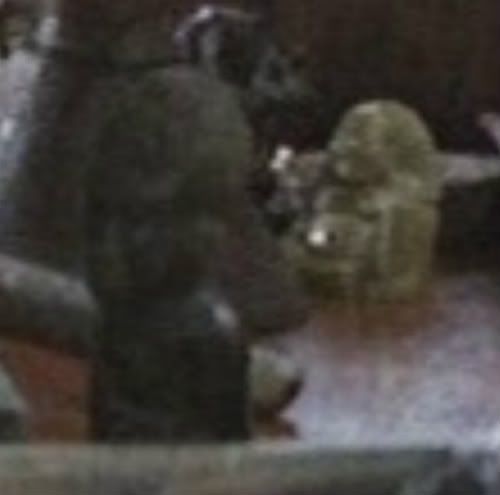
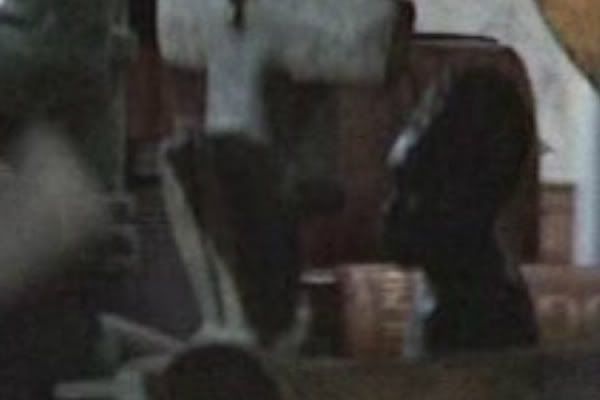
To me it looks like a female face and it facial features look African.
It looks like the wonderful portrait busts of the Ife queens in Nigeria (and Benin) from the 13th century.
They are mostly lifesized and made out of bronze.
Some also of terracotta.
Jones version must be a scaled replica made of ebony.


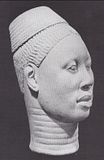

In the following chapters we will reveal the objects, which are behind the Aztec noble statue and the headrest.
 (Click to enlarge)
(Click to enlarge)Behind the Cyprus Idol and the tomahawk we can see a little bust.


To me it looks like a female face and it facial features look African.
It looks like the wonderful portrait busts of the Ife queens in Nigeria (and Benin) from the 13th century.
They are mostly lifesized and made out of bronze.
Some also of terracotta.
Jones version must be a scaled replica made of ebony.




Last edited:
James Earl Cash
Active Member
Well this was my first thought back then in 2011.
After many years I have taken a look on this bust again, which I assumed as a scaled wooden Ife queen bust.
It wasn’t possible to find an Ife sculpture made of wood. Only in bronze and a few in terracotta. There was also nothing in that size.
We have two screenshots of this bust and I found one more, which reveals, what it is. It’s definitely not a Ife queen bust.
Here a sketch I made based on the screenshots:
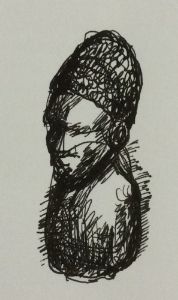
And here the screenshots:
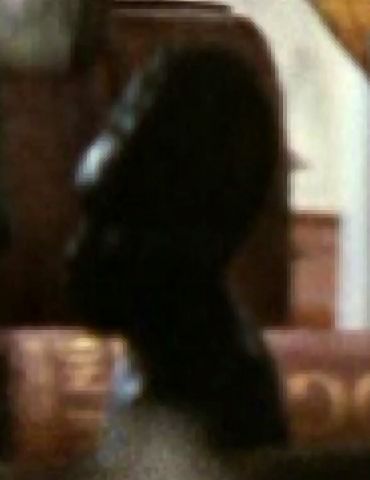
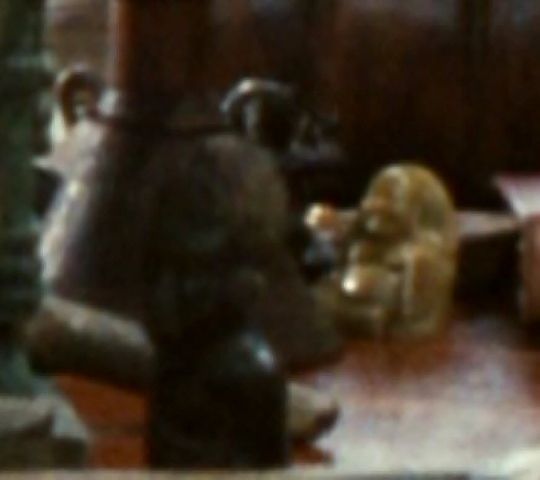
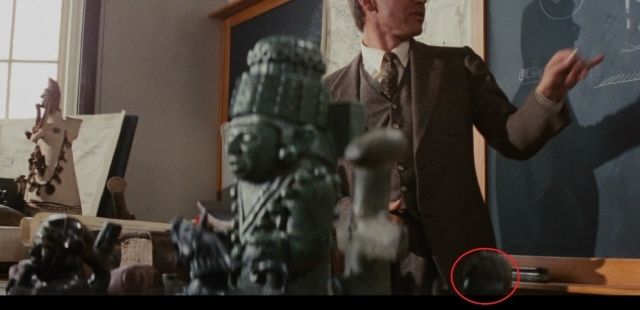

Look closely on the second and third screenshot. While the camera is moving in this scene over Indys desk, the top of the bust’s head comes in the view.
It’s definitely brighter than the rest of the bust.
So I'm sure, that it’s a carved stone Shona bust from Zimbabwe. Here some examples:
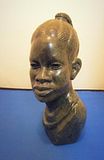
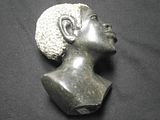
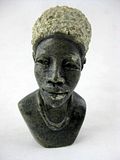

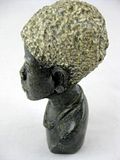
After many years I have taken a look on this bust again, which I assumed as a scaled wooden Ife queen bust.
It wasn’t possible to find an Ife sculpture made of wood. Only in bronze and a few in terracotta. There was also nothing in that size.
We have two screenshots of this bust and I found one more, which reveals, what it is. It’s definitely not a Ife queen bust.
Here a sketch I made based on the screenshots:

And here the screenshots:




Look closely on the second and third screenshot. While the camera is moving in this scene over Indys desk, the top of the bust’s head comes in the view.
It’s definitely brighter than the rest of the bust.
So I'm sure, that it’s a carved stone Shona bust from Zimbabwe. Here some examples:





Similar threads
- Replies
- 1
- Views
- 1,244
- Replies
- 1
- Views
- 1,637
- Replies
- 3
- Views
- 438
- Replies
- 7
- Views
- 1,857

